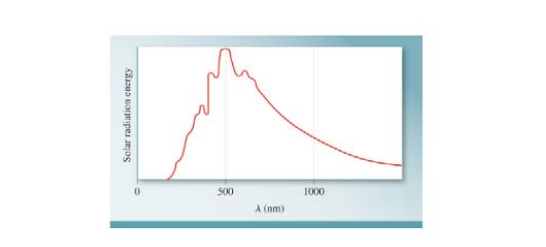
Concept explainers
Blackbody radiation is the term used to describe the dependence of the radiation energy emitted by an object on wavelength at a certain temperature. Planck proposed the quantum theory to account for the dependence Shown in the figure is a plot of the radiation energy emitted by our sun versus wavelength This curve is characteristic of objects at about 6000 K. which is the temperature at the surface of the sun. At a higher temperature, the curve has a similar shape but the maximum will shift to a shorter wavelength (a) What does this curve reveal about two consequences of great biological significance on Faith? (b) How are astronomers able to determine the temperature at the surface of stars in general?

Want to see the full answer?
Check out a sample textbook solution
Chapter 6 Solutions
CHEMISTRY(LOOSELEAF W/CODE)- CUSTOM
Additional Science Textbook Solutions
The Organic Chem Lab Survival Manual: A Student's Guide to Techniques
Organic Chemistry
Elementary Principles of Chemical Processes, Binder Ready Version
Chemistry: Atoms First
Organic Chemistry As a Second Language: Second Semester Topics
- In 1885, Johann Balmer, a mathematician, derived the following relation for the wavelength of lines in the visible spectrum of hydrogen =364.5 n2( n2 4) where in nanometers and n is an integer that can be 3, 4, 5, . . . Show that this relation follows from the Bohr equation and the equation using the Rydberg constant. Note that in the Balmer series, the electron is returning to the n=2 level.arrow_forwardWhat experimental evidence supports the quantum theory of light? Explain the wave-particle duality of all matter .. For what size particles must one consider both the wave and the particle properties?arrow_forward6.99 The photoelectric effect can he used in engineering designs for practical applications. For example, infrared goggles used in night-vision applications have materials that give an electrical signal with exposure to the relatively long wavelength IR light. If the energy needed for signal generation is 3.51020J , what is the wavelength and frequency of light that barely can be detected?arrow_forward
- 6.93 A mercury atom is initially in its lowest possible (or ground state) energy level. The atom absorbs a photon with a wavelength of 185 nm and then emits a photon with a frequency of 4.9241014HZ . At the end of this series of transitions, the atom will still be in an energy level above the ground state. Draw an energy-level diagram for this process and find the energy of this resulting excited state, assuming that we assign a value of E = 0 to the ground state. (This choice of E = 0 is not the usual convention, but it will simplify the calculations you need to do here.)arrow_forwardTraffic signals are often now made of LEDs (light-emitting diodes). Amber and green ones are pictured here. (a) The light from an amber signal has a wave-length of 595 nm, and that from a green signal has a wavelength of 500 nm. Which has the higher frequency? (b) Calculate the frequency of amber light.arrow_forwardImagine a world in which the rule for the l quantum number is that values start with 1 and go up to n. The rules for the n and mi quantum numbers are unchanged from those of our world. Write the quantum numbers for the first two shells (i.e., n = 1 and n = 2).arrow_forward
- What is the wavelength of a proton traveling at a speed of 6.21 km/s? What would be the region of the spectrum for electromagnetic radiation of this wavelength?arrow_forwardUse the mathematical expression for the 2pz wave function of a one-electron atom (see Table 5.2) to show that the probability of finding an electron in that orbital anywhere in the x-y plane is 0. What are the nodal planes for a dxz orbital and for a dx2y2 orbital?arrow_forwardAn FM radio station found at 103.1 on the FM dial broadcasts at a frequency of 1.031188s1 (103.1 MHz). What is the wavelength of these radio waves in meters?arrow_forward
 Chemistry: The Molecular ScienceChemistryISBN:9781285199047Author:John W. Moore, Conrad L. StanitskiPublisher:Cengage Learning
Chemistry: The Molecular ScienceChemistryISBN:9781285199047Author:John W. Moore, Conrad L. StanitskiPublisher:Cengage Learning Chemistry for Engineering StudentsChemistryISBN:9781337398909Author:Lawrence S. Brown, Tom HolmePublisher:Cengage Learning
Chemistry for Engineering StudentsChemistryISBN:9781337398909Author:Lawrence S. Brown, Tom HolmePublisher:Cengage Learning Chemistry: An Atoms First ApproachChemistryISBN:9781305079243Author:Steven S. Zumdahl, Susan A. ZumdahlPublisher:Cengage Learning
Chemistry: An Atoms First ApproachChemistryISBN:9781305079243Author:Steven S. Zumdahl, Susan A. ZumdahlPublisher:Cengage Learning ChemistryChemistryISBN:9781305957404Author:Steven S. Zumdahl, Susan A. Zumdahl, Donald J. DeCostePublisher:Cengage Learning
ChemistryChemistryISBN:9781305957404Author:Steven S. Zumdahl, Susan A. Zumdahl, Donald J. DeCostePublisher:Cengage Learning
 Physical ChemistryChemistryISBN:9781133958437Author:Ball, David W. (david Warren), BAER, TomasPublisher:Wadsworth Cengage Learning,
Physical ChemistryChemistryISBN:9781133958437Author:Ball, David W. (david Warren), BAER, TomasPublisher:Wadsworth Cengage Learning,





